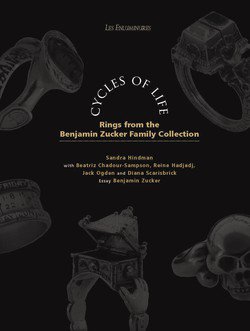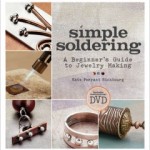Jewellery in Israel: Multicultural Diversity 1948 to the Present
- Iris Fishof
- 224 pages, illustrated, B&W and color
- Hardcover
- Publisher: Arnoldsche Art Publishers,
- 2013
In Jewellery in Israel: Multicultural Diversity, 1948 to the Present, art historian, Iris Fishof, writes “Jewellery can reflect the history of the society of which it is a part.” She uses this idea as a lens to examine the influence of immigration on her country’s jewelry design heritage, as Israel is a nation of immigrants.
Fishof sets the stage in the first chapter, “Prelude: Jewellery in Pre-State Israel,” which traces Israeli jewelry to the earliest “souvenir” jewelry made by Muslim artists in the region primarily for Christian pilgrims to Jerusalem. She explains that as Zionism–the movement to establish a Jewish state in Israel—was established in the early years of the 20th century, it included the intention to create an arts and crafts school as part of the effort to develop an Israeli identity. This became the Bezalel School of Arts and Crafts which, through many name and leadership changes, was to have a great and continuing impact on the jewelry of Israel.
At the beginning the school focused on developing a “Hebrew” style, which included design motifs such as the Hebrew alphabet, Jewish symbols, biblical scenes, and the flora, fauna and sites of the Holy Land. But as the rise of the Nazis during the 1930s led to the first wave of European immigrants, the work of German metalsmiths, steeped in modernism and the Bauhaus philosophy of unadorned simplicity, began to have a significant impact. Their influence on the Israeli style would last for the next 30 or more years.
After World War II and the establishment of the state of Israel, Jewish immigrants from all over the world found their way to Israel, doubling the region’s population. “The Melting Pot: 1950s to 1970s,” describes how Jewish immigrants, at first urged to give up their cultural identity in favor of an Israeli one, struggled to make a living from the harsh land. During this period, immigrants from Yemen, with centuries of traditional Islamic jewelry design influence behind them, had a strong and lasting impact on the jewelry of Israel. Because the ethnicity of the jewelry was not marketable to women of the time, Fishof describes how jewelry made by Yemeni craftsmen, would be “adjusted to the demands and tastes of modern women by other craftsmen.” Essentially, the pieces were taken apart and reassembled into something more contemporary. One of the first designers to make contemporary jewelry that echoed traditional styles without the use of traditionally made components was Finy Leitersdorf. Her use of desert-worn glass fragments in her designs would presage the use of non-precious metals in the designer jewelry that followed.
In the 1960s, as Israel moved from “Isolation to Exposure” (Chapter 3) in terms of jewelry, Israeli designers who had studied abroad and foreign designers who came to Israel to teach brought in new influences. Israeli designers began experimenting with different styles and materials, integrating them into the Israeli design esthetic that had been developing in isolation for twenty or more years.
It’s at this point that artist jewelers began to have a large impact on Israeli jewelry design and the influence of the Bauhaus began to fade. It is also at this point the emphasis in Fishof’s book moves away from the effect of multicultural diversity and immigration on Israeli jewelry. Chapter 4, “International Recognition,” focuses on the work and background of four Israeli artist jewelers whose work was recognized outside of Israel– Bianca Eshel Gershuni, Vered Kaminski, Esther Knobel, and Deganit Stern Schocken—who were either born in Israel or immigrated with their parents at a very young age. As these women became instructors at Bezalel, their work has a continuing impact on emerging Israeli artists
In the final chapter, “The Contemporary Scene,” Fishof brings us to the present, and demonstrates how far Israeli jewelry has come from the “Hebrew style” of the early Bezalel School of Art and Crafts. Yet many influences are still there, particularly in the use of botanical and religious images, although these are often more abstract than the originals. There are pieces based on motifs from rural regions of Israel as well as those from urban areas. The work is often narrative, meant to tell or comment on personal or family stories, such as a necklace by Knobel from the previous chapter, entitled Pine Tree Needles, which Fishof writes is “shaped like the actual pine needle necklaces habitually made by children in Israel.” As Israel is a country that has spent the last 70-plus years forging an identity in a climate of recurrent war, there are numerous pieces incorporating the topic of war, either of survival or protest.
Like many other artist jewelers from around the world at this time period, the work of work of contemporary jewelry artists include non-precious materials as well as precious ones. In Israeli jewelry, non-precious materials may include broken tiles, stones, protective steel mesh, or crushed beverage cans from Israel.
One of the questions Fishof asks in her final chapter is “Is there a concept such as Israeli jewelry?” She concludes that there is. On my first reading, I felt I disagreed with her: many art jewelry designers today use less expensive or even throwaway materials, use elements from their surroundings, and tell personal and even painful narratives. But on a second reading, I changed my mind. What else can better make up a national design concept than images, colors, and materials taken from the artist’s surroundings and drawn from their cultural and/or artistic heritage?
Any book such as this that documents the jewelry history of a people must be well illustrated in order to demonstrate the points the author is making. A difficult task, yet “Jewellery in Israel: Multicultural Diversity 1948 to the Present,” richly illustrated with black and white images as well as color—many of them full page–does an excellent job of helping the author make her points clear.
At a few points, the history telling is a bit choppy. For example, in the first chapter, the Yemeni silversmiths are mentioned, leading the reader to believe they were part of the pre-state jewelry manufacturing in Israel. Only in the second chapter do we learn that most Yemeni artists immigrated to Israel in the 1940s after Israel became a state. Some of the difficulties with the narrative flow, however, may be due to the book’s migration through translation.
I would have been interested to learn what, if any, influence Palestinian work might have on Israeli jewelry design. Fishof mentions the effect the ongoing conflict has on the narrative in the jewelry but doesn’t mention whether there is design influence as well. Fishof also mentions the recent influx of African immigrants. It may be too early to know what influence African jewelry makers may bring to the art of Israeli jewelry.
All in all, a very recommended read for anyone interested in ethnic jewelry or contemporary art jewelry from a country whose impact in jewelry design is greater than the size of the country and the length of its history might suggest.
This review first appeared in Gems & Gemology.
Like this:
Like Loading...
 Cycles of Life: Rings from the Benjamin Zucker Family Collection; Sandra Hindman, with Beatriz Chadour-Sampson, Reine Hadjadj, Jack Ogden and Diana Scarisbrick; With an essay by Benjamin Zucker; Paul Holberton Publishing, London; 258 pages, color illustrations; ISBN 9780991517237; $50.00
Cycles of Life: Rings from the Benjamin Zucker Family Collection; Sandra Hindman, with Beatriz Chadour-Sampson, Reine Hadjadj, Jack Ogden and Diana Scarisbrick; With an essay by Benjamin Zucker; Paul Holberton Publishing, London; 258 pages, color illustrations; ISBN 9780991517237; $50.00

